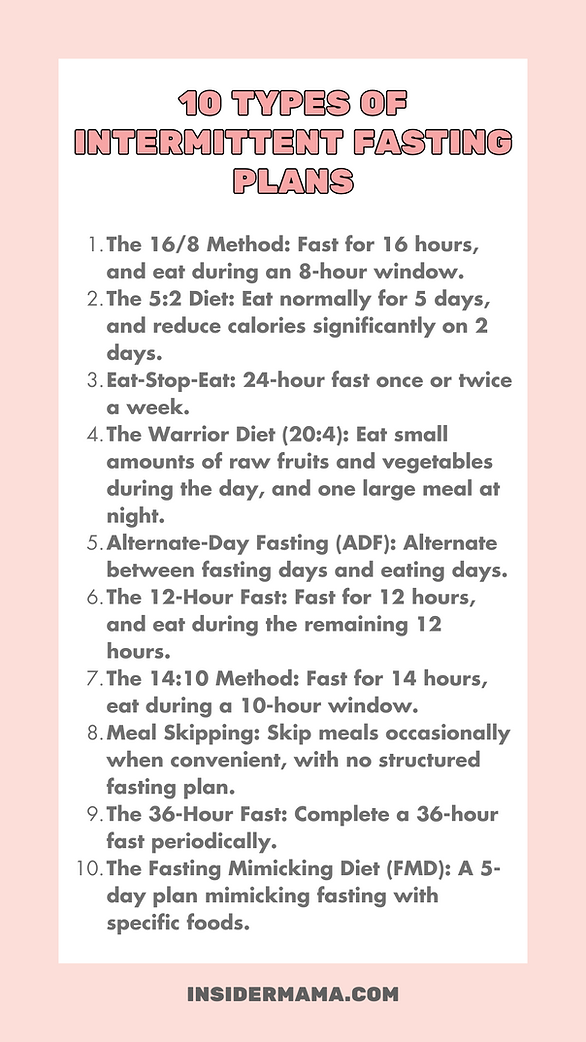
Let’s chat about intermittent fasting, a topic that’s been getting a lot of buzz lately. Now, you might be wondering if this is something that can fit into your busy, sometimes chaotic, life as a mom. Well, you’re in the right place. This post is all about breaking down intermittent fasting in a way that’s easy to understand and realistic for us moms.
What Is Intermittent Fasting?
Simply put, intermittent fasting (IF) is a way of eating that cycles between periods of eating and not eating. It’s not so much about what foods you eat, but more about when you eat them. There are different ways to do it, but the most common include the 16/8 method, where you fast for 16 hours and eat during an 8-hour window, and the 5:2 method, where you eat normally for 5 days of the week and reduce your calorie intake for the other 2 days.
Why Are Moms Trying It?
- Weight Loss: Many moms turn to IF to help shed some of that stubborn weight. By limiting the time you eat, you might naturally reduce your calorie intake.
- Simplicity: Let’s face it, counting calories or preparing special meals can be a hassle. IF offers a straightforward approach without the need for complicated diet plans.
- Health Benefits: Some research suggests that IF can improve blood sugar levels, decrease risk factors for heart disease, and even boost brain health. Who doesn’t want that?
Fitting Intermittent Fasting (IF) into Mom Life
Getting Started
Begin with a shorter fasting period and gradually increase it. For instance, start by fasting for 12 hours (which, let’s be honest, happens on busy days anyway), and then stretch it to 14 or 16 hours.
Planning Your Eating Window
Pick an eating window that suits your schedule. If breakfast feels like a family ritual you can’t miss, consider an earlier eating window. If dinner is your main meal, shift the window to later in the day.
Listen to Your Body
This is key. If you’re feeling weak or overly hungry, it’s okay to adjust. Remember, you’re a mom, and your body has different needs, especially if you’re nursing or running after toddlers all day.
10 Types of Intermittent Fasting Plans for Moms
1. The 16/8 Method
- How It Works: You fast for 16 hours and eat during an 8-hour window each day. For example, if you finish dinner by 8 PM, you’ll eat your next meal at noon the following day.
- Benefits: It’s relatively easy to follow, especially if you’re used to skipping breakfast. It can lead to reduced calorie intake and weight loss.
- Downsides: Skipping breakfast might be challenging for some, especially if morning meals are a family routine. It can also be tough if you’re a morning person who wakes up hungry.
2. The 5:2 Diet
- How It Works: You eat normally for 5 days of the week and reduce your calorie intake to about 500-600 calories on the other 2 days.
- Benefits: It allows more flexibility on most days of the week. It’s less about completely fasting and more about calorie reduction.
- Downsides: The low-calorie days can be challenging and may lead to hunger or low energy, which can be tough when juggling mom duties.
3. Eat-Stop-Eat
- How It Works: Once or twice a week, you don’t eat anything from dinner one day until dinner the next day, making a full 24-hour fast.
- Benefits: It’s straightforward and can effectively reduce weekly calorie intake.
- Downsides: A full 24-hour fast can be quite challenging and might not be suitable if you have a physically demanding routine or are new to fasting.
4. The Warrior Diet (20:4)
- How It Works: You eat small amounts of raw fruits and vegetables during the day and have one large meal at night.
- Benefits: The diet focuses on whole, unprocessed foods which are great for overall health.
- Downsides: The eating pattern can be difficult to maintain and is not ideal for those who prefer regular meals throughout the day.
The Warrior Diet, also known as the 20:4 intermittent fasting method, involves fasting for 20 hours and eating within a 4-hour window each day. During the fasting period, small amounts of raw fruits, vegetables, or some protein are allowed, leading up to a substantial meal in the 4-hour window. This diet is inspired by the eating habits of ancient warriors, as described by its creator Ori Hofmekler. They would eat minimally during the day and have a large meal at night, focusing on whole, unprocessed foods.
5. Spontaneous Meal Skipping (i.e. an intermittent fasting plan most moms probably do)
- How It Works: Skip meals when convenient. You don’t need to follow a structured fasting plan but skip meals from time to time.
- Benefits: It’s the most flexible method. You can decide to skip a meal based on your schedule and hunger levels.
- Downsides: Without a plan, some might struggle to see consistent results.
6. Alternate-Day Fasting (ADF)
- How It Works: You alternate between fasting days and eating days. On fasting days, you either consume very few calories or none at all, and on eating days, you eat normally.
- Benefits: ADF can be effective for weight loss and improving metabolic health.
- Downsides: It can be quite challenging to fast every other day, which may not be sustainable for everyone, especially for busy moms.
7. The 12-Hour Fast
- How It Works: This is a milder form of fasting where you fast for 12 hours a day and eat during the remaining 12 hours. For example, if you finish dinner by 7 PM, you will not eat until 7 AM the next day.
- Benefits: It’s a more gentle introduction to IF and can be easier to stick with. It’s also more aligned with a natural eating pattern for some people.
- Downsides: Since it’s a shorter fasting period, the benefits might not be as pronounced as with longer fasting methods.
8. The 14:10 Method
- How It Works: Similar to the 16/8 method, but with a shorter fasting window. You fast for 14 hours and eat during a 10-hour window.
- Benefits: It offers a bit more flexibility than the 16/8 method, making it a good option for those who find a 16-hour fast too challenging.
- Downsides: Like the 12-hour fast, the effects might be subtler compared to methods with longer fasting periods.
9. The 36-Hour Fast
- How It Works: This involves a full 36-hour fast. For example, if you eat dinner on day one, you would skip all meals on day two and not eat again until breakfast on day three.
- Benefits: It’s a more intense form of fasting that can lead to significant calorie reduction and potential weight loss.
- Downsides: This is quite a challenging fasting method and might not be suitable for those new to intermittent fasting or with a heavy daily routine.
10. The Fasting Mimicking Diet (FMD)
- How It Works: Developed by Dr. Valter Longo, the FMD is a 5-day plan that mimics fasting while allowing you to eat small amounts of specific foods. It’s typically done once a month.
- Benefits: It’s designed to provide the benefits of fasting while minimizing the risks and discomfort of complete food abstinence.
- Downsides: It requires careful planning and specific food choices, which might be more complicated than other IF methods.
Mom’s Tips for Successful Intermittent Fasting
When considering intermittent fasting, it’s important to keep a few key points in mind for a successful and healthy experience:
- Nutritional Needs: No matter which fasting method you choose, it’s vital to ensure you’re getting all the necessary nutrients. This is especially important for moms who require additional energy for their daily tasks. When you eat, focus on nutrient-rich foods like vegetables, fruits, proteins, and whole grains to maximize your nutritional intake.
- Lifestyle Fit: Select a fasting method that meshes well with your daily routine. For instance, if your mornings are hectic with kid-related activities, opting for a fasting plan that requires skipping breakfast might not be the best choice.
- Health Status: Always consult with a healthcare professional before starting any new diet, particularly if you have existing health conditions, or if you are pregnant or breastfeeding. Your health and well-being should be the top priority.
- Listen to Your Body: The most important aspect of intermittent fasting is to be attuned to how you feel. If a certain method leaves you feeling weak, overly hungry, or stressed, it may not be the right approach for you. Flexibility is key – it’s perfectly okay to adjust your fasting window as needed.
- Stay Hydrated: Keep up your water intake during fasting periods. This helps manage hunger and maintains overall hydration, contributing to a better feeling throughout the day.
- Be Flexible and Connect: Life can be unpredictable, especially as a mom. If your fasting schedule doesn’t go as planned on certain days, don’t be hard on yourself. Adjusting is part of the process. Also, connecting with other moms who are exploring or practicing intermittent fasting can provide invaluable support and motivation. Sharing experiences and tips can make your intermittent fasting journey more manageable and enjoyable.
Intermittent fasting can be a practical approach to eating for moms, but it’s not a one-size-fits-all solution. It’s all about finding what works for your body and your lifestyle.
- The 16/8 Method: Fast for 16 hours, and eat during an 8-hour window.
- The 5:2 Diet: Eat normally for 5 days, and reduce calories significantly on 2 days.
- Eat-Stop-Eat: 24-hour fast once or twice a week.
- The Warrior Diet (20:4): Eat small amounts of raw fruits and vegetables during the day, and one large meal at night.
- Alternate-Day Fasting (ADF): Alternate between fasting days and eating days.
- The 12-Hour Fast: Fast for 12 hours, and eat during the remaining 12 hours.
- The 14:10 Method: Fast for 14 hours, eat during a 10-hour window.
- Meal Skipping: Skip meals occasionally when convenient, with no structured fasting plan.
- The 36-Hour Fast: Complete a 36-hour fast periodically.
- The Fasting Mimicking Diet (FMD): A 5-day plan mimicking fasting with specific foods.

Final Thoughts on Intermittent Fasting for Moms
Intermittent fasting offers a flexible, manageable approach for moms seeking a healthier lifestyle. It’s not just about losing weight; it’s about finding a rhythm that works with the demands of motherhood. Remember, the key to success with intermittent fasting lies in choosing a method that fits seamlessly into your daily routine, listening to your body, and focusing on nutritious, fiber-rich foods. By doing so, you can harness the benefits of intermittent fasting without adding stress to your already busy life. Whether you’re a new mom trying to find your footing or a seasoned pro balancing multiple schedules, intermittent fasting can be a practical, empowering tool in your journey toward wellness.



